Conservation and Education in Spanish Geoparks: Exploratory Analysis of Land Stewardship Experiences and Valuation Proposal through Outdoor Education
Abstract
:1. Introduction
2. Conceptual Framework
2.1. Spanish Geoparks
2.2. Private Management Initiatives: Land Stewardship in Spain: Theoretical and Legal Framework
2.2.1. Land Stewardship as a Land Conservation and Private Management Initiative
2.2.2. Legal Framework of Land Stewardship in Spain
2.3. Nature-Based Education
3. Materials and Methods
4. Results
4.1. Structural and Alternative Processes for the Dynamization and Territorial Development in Spanish Geoparks: From Conservationism to Participative Management
4.2. Identification of Land Stewardship Experiences in Spanish Geoparks and Nature Education: An Opportunity to Be Developed
4.2.1. Inventory of Stewardship Experiences in Spanish Geoparks
4.2.2. Land Stewardship and Nature-Based Education
4.2.3. The Case of Edunat Cooperative in Bunyola (Mallorca)
5. Discussion and Conclusions
Author Contributions
Funding
Data Availability Statement
Conflicts of Interest
References
- Adams, V.M.; Mills, M.; Weeks, R.; Segan, D.B.; Pressey, R.L.; Gurney, G.G.; Groves, C.; Davis, F.W.; Álvarez-Romero, J.G. Implementation strategies for systematic conservation planning. Ambio 2019, 48, 139–152. [Google Scholar] [CrossRef] [PubMed]
- Tiebel, M.; Mölder, A.; Plieninger, T. Small-scale private forest owners and the European Natura 2000 conservation network: Perceived ecosystem services, management practices, and nature conservation attitudes. Eur. J. For. Res. 2021, 140, 1515–1531. [Google Scholar] [CrossRef]
- Sayer, J.A. Science and international nature conservation. CIFOR Occas. Pap. 1995, 4, 14. [Google Scholar]
- Florido, G.; Lozano, P.J. Las figuras de protección de los espacios naturales en las comunidades autónomas españolas: Una puesta al día. Boletín Asoc. Geógrafos Españoles 2005, 40, 57–81. [Google Scholar]
- Nikolova, V.; Sinnyovsky, D. Geoparks in the legal framework of the EU countries. Tour. Manag. Perspect. 2019, 29, 141–147. [Google Scholar] [CrossRef]
- Pérez-Calderón, E.; Prieto-Ballester, J.M.; Miguel-Barrado, V. Perceived Rural Development in UNESCO Global Geoparks in Spain. Land 2022, 11, 1086. [Google Scholar] [CrossRef]
- Farsani, N.T.; Coelho, C.; Costa, C. Geotourism and Geoparks as Gateways to Socio-cultural Sustainability in Qeshm Rural Areas, Iran. Asia Pac. J. Tour. Res. 2012, 17, 30–48. [Google Scholar] [CrossRef]
- De Castro, E.; Loureiro, F.; Patrocínio, F.; Gomes, H.; Castel-Branco, J.; Cezar, L.; Fernandes, M.; Azevedo, P. The Estrela UNESCO Global Geopark Territorial Development Strategy: A Holistic Vision for the Twenty-First Century. In Economics and Management of Geotourism Tourism, Hospitality & Event Management, 1st ed.; Braga, V., Duarte, A., Marques, C.S., Eds.; Springer: Cham, Germany, 2022; pp. 19–46. [Google Scholar]
- UNESCO. UNESCO Global Geoparks (UGGp). Available online: https://en.unesco.org/global-geoparks (accessed on 22 June 2023).
- Pásková, M.; Zelenka, J. Sustainability management of Unesco Global Geoparks. Sustain. Geosci. Geotourism 2018, 2, 44–64. [Google Scholar] [CrossRef]
- Peris Reig, L. Outdoor Education. Una forma de Aprendizaje Significativo, 1st ed.; Punto Rojo Libros: Sevilla, Spain, 2017; p. 138. [Google Scholar]
- Troitiño Vinuesa, M.A. Espacios Naturales Protegidos y Desarrollo Rural: Una Relación Territorial Conflictiva. Boletín Asoc. Geógrafos Españoles 1995, 20, 23–37. [Google Scholar]
- Hueso-Kortekaas, K. Educar en la Naturaleza, 1st ed.; Plataforma Editorial: Barcelona, Spain, 2021; p. 256. [Google Scholar]
- Hueso-Kortekaas, K.; Iranzo-García, E. Salinas and “Saltscape” as a Geological Heritage with a Strong Potential for Tourism and Geoeducation. Geosciences 2022, 12, 141. [Google Scholar] [CrossRef]
- Sending, O.J.; Neumann, I.B. Governance to governmentality: Analyzing NGOs, states, and power. Int. Stud. Q. 2006, 50, 651–672. [Google Scholar] [CrossRef]
- Brown, J.; Mitchell, B. The stewardship approach and its relevance for protected landscapes. Georg. Wright Forum 2000, 17, 70–79. [Google Scholar]
- Mitsos, M.; Ringgold, P.C. Testing Stewardship Concepts on Federal Land. J. Sustain. For. 2001, 13, 305–320. [Google Scholar] [CrossRef]
- Mumaw, L. Transforming urban gardeners into land stewards. J. Environ. Psychol. 2017, 52, 92–103. [Google Scholar] [CrossRef]
- Basora Roca, X.; Sabaté i Rotés, X. Custodia del Territorio en la Práctica. Manual de Introducción a una Nueva estrategia Participativa de Conservación de la Naturaleza y el Paisaje, 1st ed.; Xarxa de Custodia del territorio, Fundació Territori i Paisatge—Obra Social Caixa Catalunya: Barcelona, Spain, 2006; p. 80. [Google Scholar]
- Pietx, J. Custòdia del territori a Catalunya. Medi Ambient Tecnol. Cult. 2008, 42, 34–43. [Google Scholar]
- Iranzo-García, E.; Puig Lanas, M.L. La custodia del territorio: Un instrumento para la puesta en valor colaborativa del paisaje: El caso de Castielfabib. In Objectius de Desenvolupament Sostenible en el Territori Valencià: Trobada 2020; Universitat de València: Valencia, Spain, 2020; pp. 151–163. [Google Scholar]
- Carcavilla, L.; Durán, J.J.; García-Cortés, A.; López-Martínez, J. Geological heritage and geoconservation in Spain: Past, Present, and Future. Geoheritage 2009, 1, 75–91. [Google Scholar] [CrossRef]
- Brilha, J. Geoheritage and geoparks. In Geoheritage: Assessment, Protection and Management; Reynard, E., Brilha, J., Eds.; Elsevier: Amsterdam, The Netherlands, 2018; pp. 323–335. [Google Scholar]
- Hilario, A.; Carcavilla, L. Twenty Years of Spanish Geoparks: Analysis and Future Prospects. Geoheritage 2020, 12, 87. [Google Scholar] [CrossRef]
- García-Cortés, A. Spanish Geological Frameworks. In An Approach to Spanish Geological Heritage of Internacional Relevance; Instituto Geológico y Minero de España: Madrid, Spain, 2009; p. 215. [Google Scholar]
- Álvarez, S.; Hernández, S. La custodia del territorio como instrumento complementario para la protección de espacios naturales. Rev. Catalana Dret Ambient. 2011, 2, 1–22. [Google Scholar] [CrossRef]
- Jackson, S.F.; Gaston, K.J. Incorporating private lands in conservation planning: Protected areas in Britain. Ecol. Appl. 2008, 18, 1050–1060. [Google Scholar] [CrossRef]
- Barreira, A.; Rodríguez-Guerra, M.; Puig, I.; Brufao, P. Estudio Jurídico Sobre la Custodia del Territorio; Plataforma de Custodia del Territorio de la Fundación Biodiversidad: Madrid, Spain, 2010; p. 277. [Google Scholar]
- Capdepón, M.; Durá, C.J. Introducción al concepto de la conservación privada: «nuevas» herramientas para la conservación de la biodiversidad. Ciudad Territorio. Estud. Territ. 2019, 51, 27–42. [Google Scholar]
- Brown, J.; Mitchell, B. Extending the reach of national parks and protected areas: Local stewardship initiatives. In National Parks and Protected Areas: Keystones to Conservation and Sustainable Development, 1st ed.; Nelson, J.G., Serafin, R., Eds.; Springer: Berlin/Heidelberg, Germany, 1997; Volume 40, pp. 103–116. [Google Scholar]
- Borrini, G.; Farvar, M.T.; Kothari, A.; Pimbert, M.; Renard, Y. Partager le Pouvoir: Cogestion des Ressources Naturelles et Gouvernance Partagée de par le Monde; International Union for Nature Conservation (IUCN): Gland, Switzerland, 2009; p. 548. [Google Scholar]
- Fagan, S.M. An Analysis of the Evolution of Theory and Management in the Trustees of Reservations. Master’s Thesis, University of Pennsylvania, Philadelphia, PA, USA, 2008. [Google Scholar]
- Brewer, R. Conservancy: The Land Trust Movement in America; Dartmouth College Press: Lebanon, PA, USA, 2003. [Google Scholar]
- Durá Alemañ, C.J. La Custodia del Territorio y sus Nuevas Técnicas Para la Conservación del Patrimonio Natural, el Paisaje y la Biodiversidad: Un Invento Norteamericano y su Expansión al Resto del Mundo. Ph.D. Thesis, University of Alcalá de Henares, Alcalá de Henares, Spain, September 2013. [Google Scholar]
- Pietx, J. Custodia del territorio, una nueva estrategia de conservación. Quercus 2000, 169, 20–23. [Google Scholar]
- Declaración de Montesquiu. 2000. Available online: https://www.custodia-territorio.es/content/declaraci%C3%B3n-de-montesquiu-2000 (accessed on 8 March 2023).
- Ruiz, A.; Navarro, A.; Sánchez, A. Libro Blanco Construyamos el Futuro de la Custodia del Territorio; Foro de Redes y Entidades de Custodia del Territorio: Madrid, Spain, 2018. [Google Scholar]
- Racinska, I.; Barratt, L.; Marouli, C. LIFE and Land Stewardship. Current Status, Challenges and Opportunities. Report to the European Commission. 2015. Available online: https://www.landconservationnetwork.org/node/9535 (accessed on 17 January 2023).
- Kamal, S.; Grodzińska-Jurczak, M.; Brown, G. Conservation on private land: A review of global strategies with a proposed classification system. J. Environ. Plan. Manag. 2015, 58, 576–597. [Google Scholar] [CrossRef]
- Hardy, M.J.; Bekessy, S.A.; Fitzsimons, J.A.; Mata, L.; Cook, C.; Nankivell, A.; Smillie, K.; Gordon, A. Protecting nature on private land using revolving funds: Assessing property suitability. Biol. Conserv. 2018, 220, 84–93. [Google Scholar] [CrossRef]
- Groce, J.E.; Cook, C.N. Maintaining landholder satisfaction and management of private protected areas established under conservation agreements. J. Environ. Manag. 2022, 305, 114355. [Google Scholar] [CrossRef] [PubMed]
- Quer, B.; Asensio, N.; Codina, J.; Chalard, L.; Pietx, J.; Rodríguez, P. Study of the Development and Implementation of Land Stewardship in the Different Participation Regions; LANDLIFE: Girona, Spain, 2012; p. 125. [Google Scholar]
- Horton, K.; Knight, H.; Galvin, K.A.; Goldstein, J.H.; Herrington, J. An evaluation of landowners’ conservation easements on their livelihoods and well-being. Biol. Conserv. 2017, 209, 62–67. [Google Scholar] [CrossRef]
- Ruiz, A.; Arias, F.; Navarro, A. El Tercer Sector Ambiental: Un Enfoque de las Entidades Ambientales no Lucrativas; Colección Cuaderno de Campo; Asociación de Fundaciones para la Conservación de la Naturaleza: Madrid, Spain, 2016; Volume 1, p. 20. [Google Scholar]
- Asociación Nacional EDNA. Guía de escuelas en la naturaleza. In Información Práctica Sobre la Vida y Organización de Experiencias en la Naturaleza en España, 1st ed.; La Traviesa Ediciones: Málaga, Spain, 2020; p. 112. [Google Scholar]
- Chawla, L. Childhood experiences associated with care for the natural world: A theoretical framework for empirical results. Child. Youth Environ. 2007, 17, 144–170. [Google Scholar] [CrossRef]
- Matsuba, M.K.; Pratt, M.W. The Making of an Environmental Activist: A Developmental Psychological Perspective. New Dir. Child Adolesc. Dev. 2013, 142, 59–74. [Google Scholar] [CrossRef]
- Bauman, Z. Educational challenges of the liquid-modern era. Diogenes 2003, 50, 15–26. [Google Scholar] [CrossRef]
- In Natura. Available online: https://escuelainnatura.com/directorio-escuelas-en-la-naturaleza-espana/ (accessed on 5 February 2023).
- Hueso-Kortekaas, K. A critical view on the strengths and challenges of outdoor preschools and nature-based education. In Regenerative Desing in the Latin-Mediterranean Context. New Visions, Emerging Practices and Perspectives; Cobreros, C., Giorgi, E., Cattaneo, T., Eds.; Springer Nature: Cham: Switzerland, 2023; in press. [Google Scholar]
- González Río, M.J. Metodología de la Investigación Social; Aguaclara: Alicante, Spain, 1997; p. 300. [Google Scholar]
- Saldana, J. Thinking Qualitatively: Methods of Mind, 1st ed.; SAGE Publications, Inc.: Thousand Oaks, CA, USA, 2014; p. 240. [Google Scholar]
- Miles, M.B.; Huberman, A.M.; Saldana, J. Methods of Predicting Qualitative Data Analysis: A Methods Sourcebook, 4th ed.; SAGE Publications, Inc.: Thousand Oaks, CA, USA, 2014; p. 408. [Google Scholar]
- Prada, O. Informe del 6° Inventario de Iniciativas de Custodia del Territorio en España; Fundación Biodiversidad, Ministerio para la Transición Ecológica y el Reto Demográfico: Madrid, Spain, 2019; p. 223. [Google Scholar]
- Eder, E.W.; Patzak, M. Geoparks-geological attractions: A tool for public education, recreation and sustainable economic development. Episodes 2004, 3, 162–164. [Google Scholar] [CrossRef] [PubMed]
- McKeever, P.; Zouros, N.; Patzak, M. The UNESCO global network of national geoparks. In Geotourism: The Tourism of Geology and Landscape; Newsome, D., Dowling, R., Eds.; Goodfellow Publishers: Oxford, UK, 2010; pp. 221–230. [Google Scholar]
- Rosskamp, D.; Valdati, J. Geoparks and Sustainable Development: Systematic Review. Geoheritage 2023, 15, 6. [Google Scholar] [CrossRef]
- Zouros, N. The European Geoparks Network. Episodes 2004, 27, 165–171. [Google Scholar] [CrossRef]
- Sabaté, X.; Basora, X.; O’Neill, C.; Mitchell, B. Caring Together for Nature. Manual on Land Stewardship as a Tool to Promote Social Involvement with the Natural Environment in Europe, 1st ed.; xct in partnership with Eurosite, CEN L-R, Legambiente and Prysma: Barcelona, Spain, 2013. [Google Scholar]
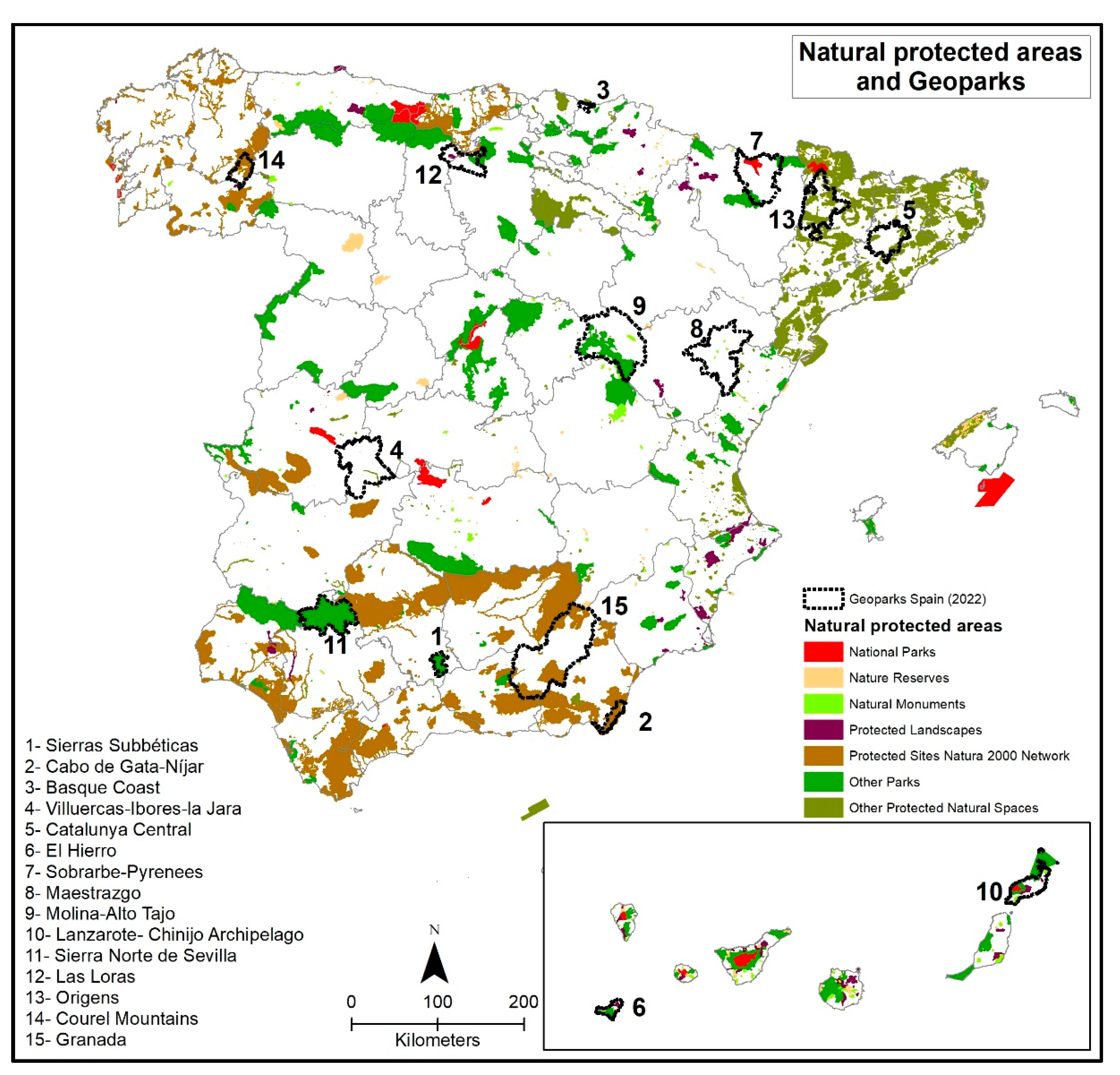
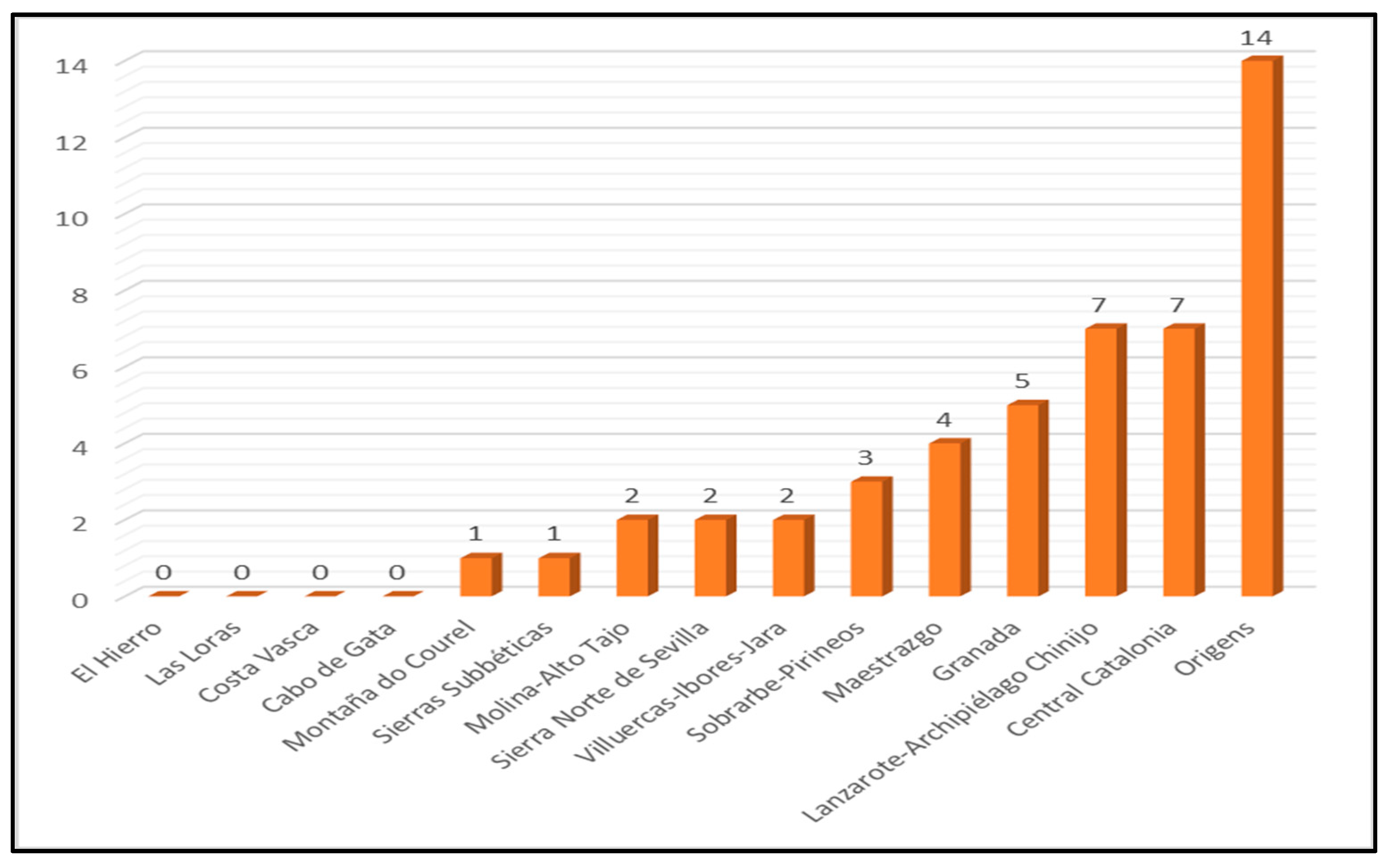
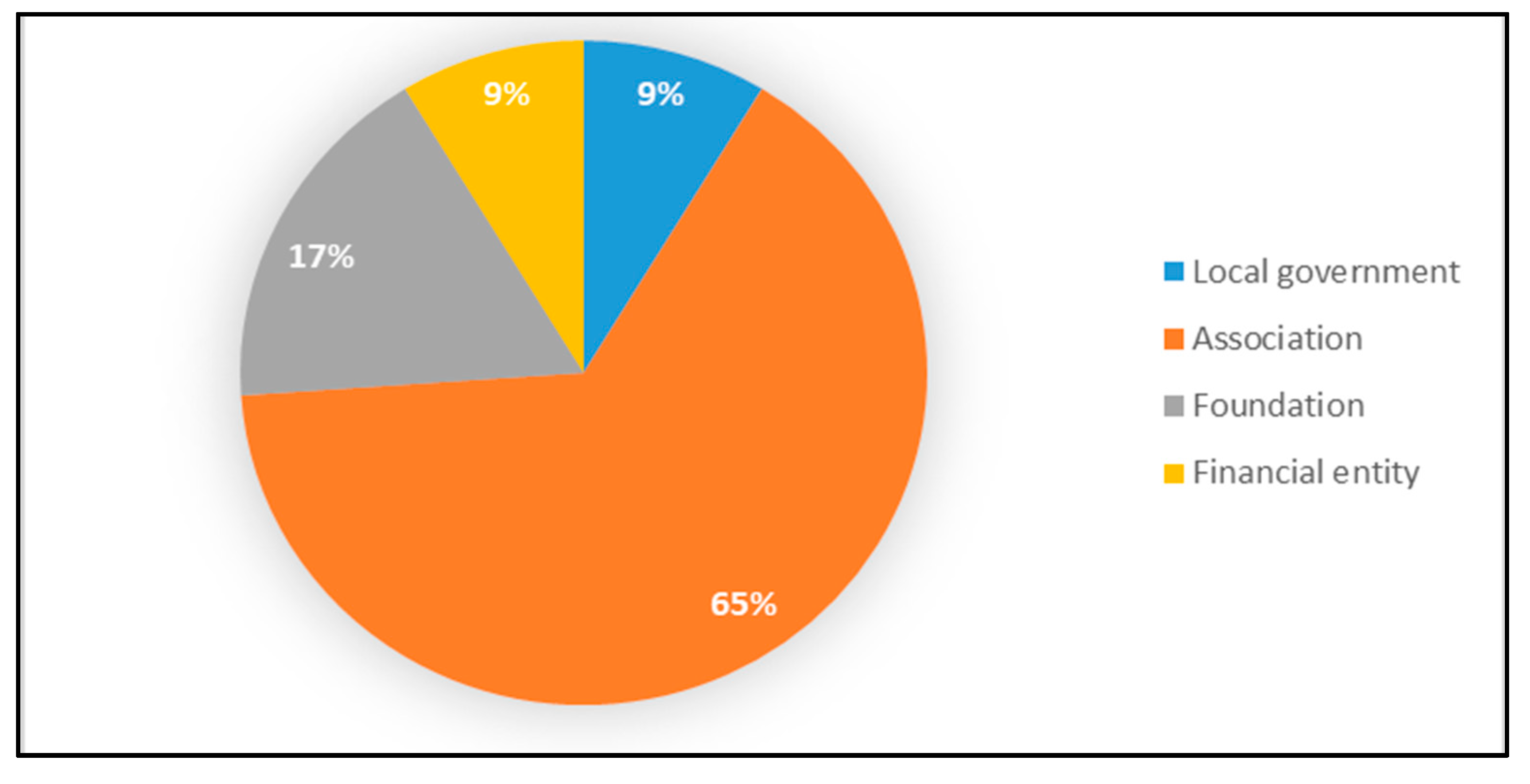
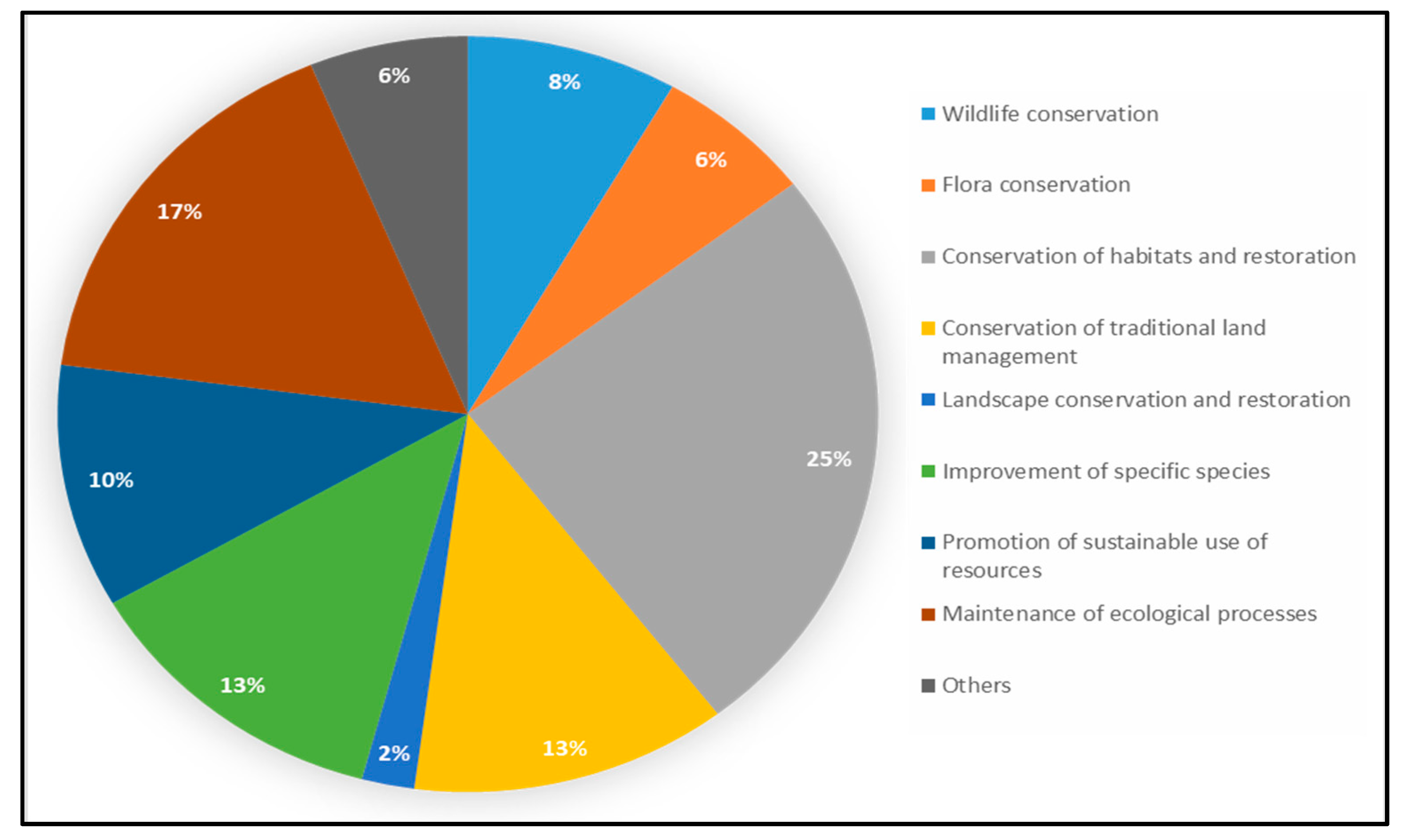
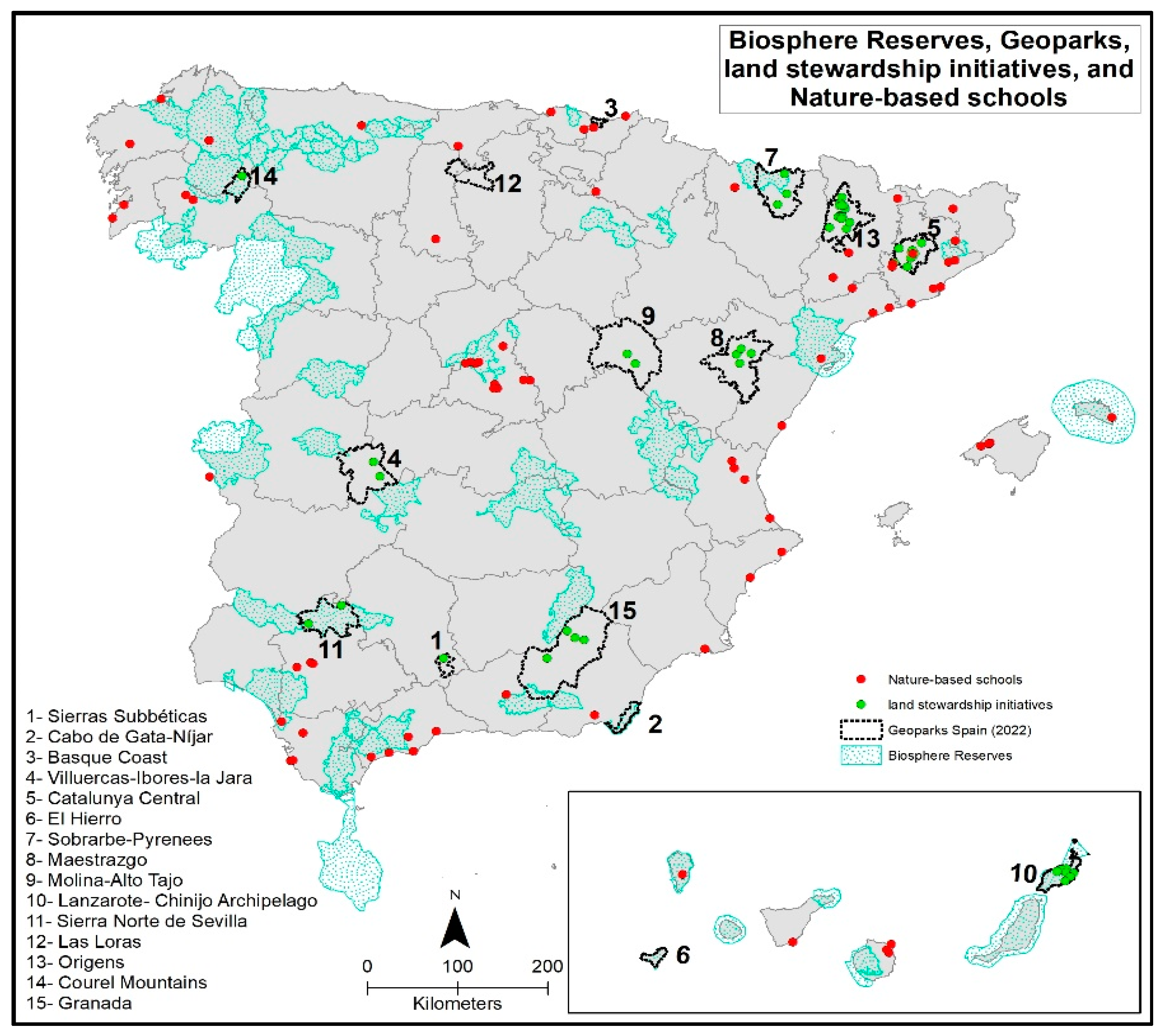
| Geopark | Name of the Initiative | Municipality | Entity | Goal of the Initiative |
|---|---|---|---|---|
| Catalunya Central | Coaner | Sant Mateu de Bages | Minyons Escoltes i Guies de Catalunya | Sustainable use of resources |
| Camí de la Gavarresa | Avinyó | Associació Hàbitats-Projecte Rius | Habitat restoration and recovery | |
| Bosc de Cal Cuques | Manresa | Fundació Catalunya la Pedrera | Habitat restoration and recovery | |
| Custodia fluvial riu Cardener | Manresa | Ayuntamiento de Manresa | Ecological processes | |
| Aiguamolls de la Bóbila de Santpedor | Santpedor | Obra Social Caixa Catalunya | Habitat conservation | |
| Bosc de Mas Lluca | Santpedor | Fundació Catalunya la Pedrera | Habitat restoration and recovery | |
| Món Sant Benet | Sant Fruitòs del Bagés | Fundació Catalunya la Pedrera | Sustainable use of resources | |
| Origens | APC Gavet de la Conca | Gavet de la Conca | Associació Amics Natura 2000 Pirineu | Favouring specific species |
| Els Plans d’Aguiró | Aguiró | Associació Marques de Pastor | Conservation of traditional land management | |
| Tremoluga de Naens—Foradada 1 | Naens (Senterada) | Associació Marques de Pastor | Habitat conservation | |
| Tremoluga de Naens—Foradada 2 | Naens (Senterada) | Associació Marques de Pastor | Habitat conservation | |
| Tremoluga de Naens—Foradada 3 | Naens (Senterada) | Associació Marques de Pastor | Habitat conservation | |
| PAS del Codó | Senterada | Associació Trenca | Favouring specific species | |
| Les Feixes | La Pobla de Segur | Associació Amics Natura 2000 Pirineu | Ecological processes | |
| Seixos | Talarn | Ajuntament de Talarn | Ecological processes | |
| Vedat | Talarn | Ajuntament de Talarn | Ecological processes | |
| Roqueres 1 | Talarn | Ajuntament de Talarn | Ecological processes | |
| Roqueres 2 | Talarn | Ajuntament de Talarn | Ecological processes | |
| Farratge | Talarn | Ajuntament de Talarn | Ecological processes | |
| Siall | Isona | Associació Trenca | Ecological processes | |
| Congost de Mont-rebei | Sant Esteve de la Sarga | Fundació Catalunya la Pedrera | Conservation of traditional land management | |
| Granada | Coto de caza De Castril | Castril | Fundación GYPAETUS | Promotion of the sustainable use of resources |
| Viveros Ponce Lajara | Galera | Asociación para la Custodia del Territorio y el Desarrollo Sostenible ACUDE | Conservation of traditional land management | |
| Los Isidoros | Castillejar | Asociación para la Custodia del Territorio y el Desarrollo Sostenible ACUDE | Conservation of traditional land management | |
| GRA-1 | Gorafe | Fundación de Amigos del Águila Imperial, Lince Ibérico y Espacios Nat de Carácter Privado | Preservation of fauna | |
| Olivares Vicos + | Guadix | Seo Birdlife | Habitat restoration and recovery | |
| Montaña do Courel | Microrreservas da Serra do Courel | Folgoso do Courel | Asociación Galega de Custodia do Territori | Preservation of flora |
| Sobrarbe-Pirineos | Estación Biologica Mte. Perdido (EBMP) | Bielsa | Fundación para la Conservación del Quebrantahuesos | Preservation of fauna |
| Ayuntamiento de Ainsa-Sobrarbe | Ainsa | Fundación para la Conservación del Quebrantahuesos | Sustainable use of resources | |
| Refugio Natural de la Peña Montañesa | Pueyo de Araguas | Fundación para la Conservación del Quebrantahuesos | Conservation of traditional land management | |
| Maestrazgo | Resforestación de zonas afectadas por incendio | Ejulve | Asociación para el Desarrollo del Maestrazgo | Habitat restoration and recovery |
| Guardianes del territorio | Molinos | Asociación para el Desarrollo del Maestrazgo | Habitat conservation | |
| Escuela de Actividades de la Naturaleza S. L. | Castellote | Asociación para el Desarrollo del Maestrazgo | Sustainable use of resources | |
| Mejora de hábitats y recursos turísticos con hides fotográficos. | Montoro de Mezquita | Asociación para el Desarrollo del Maestrazgo | Habitat restoration and recovery | |
| Molina-Alto Tajo | La Huerta Rigüela | Valhermoso | Asociación Nacional MICORRIZA | Others |
| La Sarga del Masegar | Pinilla de Molina | Asociación Nacional MICORRIZA | Others | |
| Sierras Subbéticas | Las Quebradillas | Zuheros | Fundación Internacional para la Restauración de Ecosistemas | Conservation of traditional land management |
| Sierra Norte de Sevilla | SEV-2 | Alanís | Fundación de Amigos del Águila Imperial, Lince Ibérico y Espacios Nat de Carácter Privado | Preservation of fauna |
| Almadén de la Plata | Almadén de la Plata | SEO/BirdLife, Sociedad Española de Ornitología | Favouring specific species | |
| Villuercas-Ibores-Jara | Conservación integral de valores medioambientales | Navatrasierra | Sociedad Extremeña de Zoología | Preservation of flora |
| CC-1 | Alia | Fundación de Amigos del Águila Imperial, Lince Ibérico y Espacios Nat de Carácter Privado | Preservation of fauna | |
| Lanzarote-Archipiélago Chinijo | Muladar en PEÑA HUMAR | Teguise | Asociación de defensa medio ambiental vientos del noreste | Favouring specific species |
| La Cuestita | Teguise | Asociación Paisajes Atlánticos | Habitat restoration and recovery | |
| Surte Gorritz | Teguise | Asociación de defensa medio ambiental vientos del noreste | Favouring specific species | |
| Sembrando para hubaras | Teguise | Asociación de defensa medio ambiental vientos del noreste | Favouring specific species | |
| El Higueral | Teguise | Asociación Paisajes Atlánticos | Conservation and improvement of landscape | |
| Vivero Ferrovial | Arrecife | Asociación Ambiental Arrecife Natura | Preservation of flora | |
| Huerta Vieja | Tinajo | Asociación Cultural y Social Trib-Arte | Conservation of traditional land management |
Disclaimer/Publisher’s Note: The statements, opinions and data contained in all publications are solely those of the individual author(s) and contributor(s) and not of MDPI and/or the editor(s). MDPI and/or the editor(s) disclaim responsibility for any injury to people or property resulting from any ideas, methods, instructions or products referred to in the content. |
© 2023 by the authors. Licensee MDPI, Basel, Switzerland. This article is an open access article distributed under the terms and conditions of the Creative Commons Attribution (CC BY) license (https://creativecommons.org/licenses/by/4.0/).
Share and Cite
Iranzo-García, E.; Hueso-Kortekaas, K.; Fansa-Saleh, G. Conservation and Education in Spanish Geoparks: Exploratory Analysis of Land Stewardship Experiences and Valuation Proposal through Outdoor Education. Geosciences 2023, 13, 276. https://doi.org/10.3390/geosciences13090276
Iranzo-García E, Hueso-Kortekaas K, Fansa-Saleh G. Conservation and Education in Spanish Geoparks: Exploratory Analysis of Land Stewardship Experiences and Valuation Proposal through Outdoor Education. Geosciences. 2023; 13(9):276. https://doi.org/10.3390/geosciences13090276
Chicago/Turabian StyleIranzo-García, Emilio, Katia Hueso-Kortekaas, and Ghaleb Fansa-Saleh. 2023. "Conservation and Education in Spanish Geoparks: Exploratory Analysis of Land Stewardship Experiences and Valuation Proposal through Outdoor Education" Geosciences 13, no. 9: 276. https://doi.org/10.3390/geosciences13090276
APA StyleIranzo-García, E., Hueso-Kortekaas, K., & Fansa-Saleh, G. (2023). Conservation and Education in Spanish Geoparks: Exploratory Analysis of Land Stewardship Experiences and Valuation Proposal through Outdoor Education. Geosciences, 13(9), 276. https://doi.org/10.3390/geosciences13090276










